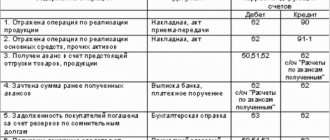Criteria for recognizing assets as financial investments
Not all objects are recognized as financial investments. The regulatory conditions for classifying assets as financial investments are listed in clause 2 of the Regulations. Several criteria must be met at the same time:
- The company has properly completed documentation for ownership rights to the object and benefits (money or assets) from its use.
- Transfer to the company of all risks arising from the ownership of investments - this is, for example, the risk of low liquidity, insolvency of the company, price fluctuations, etc.
- The actual ability to provide a company with various benefits in the form of interest, cash dividends, price appreciation and other revenues in future periods.
Provisions of PBU – accounting of financial investments
Placements of funds that may or may not be classified as financial investments are listed in clauses 3-4 of the PBU. The optimal accounting unit is selected by the company independently depending on the nature of the investment - aggregate, batch, series, etc. Analytical accounting of financial investments and securities is carried out in such a way as to generate the most complete data on types (groups) of objects and counterparties (clause 6). At the same time, for securities (CS), it is necessary to at least reflect information about the name of the security and the issuer, nominal price, number and series of the security, purchase price and costs, total number of securities, dates of acquisition and sale, storage address.
We purchase financial investments
Current legislation allows a company to engage in such activities as purchasing financial investments (shares in authorized capital) using raised funds in order to receive dividends. There are no prohibitions on the use of the simplified tax system by such organizations. However, this type of activity is accompanied by the registration of numerous business transactions.
The purchase of property rights in itself, including a share in another organization, does not cause any particular difficulties from a legal point of view. The general provisions on purchase and sale apply to such transactions, unless otherwise follows from the content or nature of these rights. In addition, the procedure for the alienation of shares in an LLC is regulated in Art. 21 of the Federal Law of 02/08/1998 No. 14-FZ “On Limited Liability Companies”. However, the acquisition of financial investments requires the availability of available funds. In the absence of such, you have to use borrowed funds.
Since such situations often occur, let us consider the main business transactions that arise when carrying out such transactions.
Example.
Let’s assume that the main activity of an organization (STS with the object “income reduced by the amount of expenses”) is the acquisition of financial investments (shares in authorized capital) at the expense of raised funds in order to receive dividends, as well as the issuance of loans to other organizations in order to receive interest. Placing funds in bank accounts is not the main activity of the organization.
Recently, the organization has carried out the following business transactions:
- as a borrower, a long-term loan agreement has been concluded with an individual, providing for monthly payment of interest;
- a share in another LLC was acquired, and as a result, dividends were received;
- the received dividends were placed on deposit, and as a result, interest on the deposit was received;
- a loan was issued to another company for a period of 3 years, and under the terms of the loan agreement, interest is paid by the borrower simultaneously with the repayment of the principal debt;
- expenses are incurred to pay for bank services, pay state fees, and pay for notary services.
IMPORTANT IN WORK
For an organization, contributions to the authorized capital of other organizations are financial investments.
We are interested in the procedure for reflecting business transactions carried out by an organization in accounting and tax accounting.
Getting a loan
The principal amount of the obligation for the loan (credit) received is reflected in the accounting records of the borrowing organization as accounts payable in accordance with the terms of the loan agreement (credit agreement) in the amount specified in the agreement. Interest payable to the lender (creditor) is the cost associated with fulfilling obligations on loans and credits received, by virtue of clause 3 of PBU 15/2008. In accordance with clause 4 of PBU 15/2008, interest is reflected in accounting separately from the principal amount of the obligation for the loan (credit) received. Interest on loans received is recognized as other expenses (except for that part of them that is subject to inclusion in the cost of an investment asset) and is reflected in accounting and reporting in the reporting period to which they relate.
ORIGINAL SOURCE
The disposal of an asset as a contribution to the authorized (share) capital of another organization is not recognized as an expense.
— Clause 3 of PBU 10/99.
Paragraph 8 of PBU 15/2008 provides that interest payable to the lender (creditor) is included in other expenses evenly, as a rule, regardless of the terms of the loan (credit). In this case, it is possible to include interest payable to the lender (creditor) as part of other expenses based on the terms of the loan (credit) in the case where such inclusion does not differ significantly from uniform inclusion.
The Chart of Accounts and the Instructions for its use indicate that account 67 is intended to summarize information on the status of long-term (for a period of more than 12 months) loans and borrowings received by the organization.
Taking into account the above, transactions related to the receipt of a loan and the accrual of interest due on it are reflected in the following entries:
| Debit | Credit | Household operation |
| 51 | 67 | Long-term loan received |
| 91, subaccount “Other expenses” | 67, subaccount “Interest calculations” | The amount of interest accrued for the month is reflected in other expenses |
| 66, subaccount “Interest calculations” | 51 | The amount of interest paid within the terms established in the agreement is reflected |
| 66 | 51 | The principal amount of the loan has been repaid |
By virtue of paragraphs. 9 clause 1 art. 346.16 of the Tax Code of the Russian Federation, an organization applying the simplified tax system has the right to take into account, for tax purposes, as expenses interest paid for the provision of funds for use (credits, loans), as well as expenses associated with payment for services provided by credit institutions.
IMPORTANT IN WORK
A financial investment is accepted for accounting at its original cost.
Thus, the organization has the right to take into account for tax purposes expenses in the form of interest paid to the lender, as well as expenses for paying for bank services. In this case, expenses in the form of interest are accepted in the manner prescribed for calculating corporate income tax, art. 269 of the Tax Code of the Russian Federation, i.e., taking into account the restrictions established by Art. 269 of the Tax Code of the Russian Federation.
Acquisition of a share in the authorized capital
A monetary contribution to the authorized capital of an LLC is a financial investment for the organization (clauses 2, 3 of PBU 19/02). According to the Instructions, contributions to the authorized capitals of other organizations are reflected in the sub-account “Shares and Shares” opened to account 58. Financial investments are accounted for at their original cost (clauses 8, 9 of PBU 19/02). The initial cost of the contribution to the authorized capital of the LLC is the amount contributed to pay for the share.
If an organization paid for its share in the LLC using borrowed funds, then interest on the use of such funds is not included in the initial cost of investment in the authorized capital of the LLC, but is taken into account as part of other expenses.
In general, the acquisition of a share in the authorized capital of an LLC is reflected by the following entries:
| Debit | Credit | Household operation |
| 58, subaccount “Units and shares” | 76 | Included in financial investments is a contribution to the authorized capital of LLC |
| 76 | 51 | Paid share in the authorized capital of the LLC |
Receiving dividends
Paragraph 5 of PBU 9/99 determines that in organizations whose subject of activity is participation in the authorized capitals of other organizations, revenue is considered to be receipts of which are associated with this activity. Taking into account that the main activity of the organization is the acquisition of shares in authorized capital for the purpose of receiving dividends, we believe that dividends distributed in favor of your organization are included in income from ordinary activities (clause 34 of PBU 19/02). In letter No. 07-04-18/01 of the Ministry of Finance of Russia dated January 29, 2014, it is recommended to recognize such income minus the tax withheld by the tax agent (the source of payment of income) in accounting.
In this case, the entries reflecting the receipt of dividends will be as follows:
| Debit | Credit | Household operation |
| 76, subaccount “Calculations for due dividends and other income” | 90 | Dividends due are reflected |
| 51 | 76, subaccount “Calculations for due dividends and other income” | Dividends received minus tax withheld by the tax agent |
Taxpayers who apply the simplified tax system do not include income in the form of dividends received in the tax base when calculating tax (subclauses 2 and 3, clause 1.1, article 346.15 of the Tax Code of the Russian Federation). At the same time, dividends received are subject to income tax (clause 3 of Article 284, clauses 2 and 3 of Article 346.11 of the Tax Code of the Russian Federation). In this case, the responsibility for calculating, withholding and paying tax rests with the source of payment of income - the tax agent (Russian organization).
Placement of funds on deposit
The Instructions stipulate that information about deposit accounts is reflected in the “Deposit Accounts” subaccount opened for account 55. The Instructions directly state that the transfer of funds to a deposit is accounted for as a debit to account 55 in correspondence with account 51 or 52. When the deposit is returned, it is recorded organizations make reverse entries.
At the same time, depositing funds can be regarded as a financial investment of the organization. From paragraphs 2 and 3 of PBU 19/02 it follows that such investments include, in particular, deposits on which interest is accrued.
According to the Instructions, financial investments are reflected in account 58. Therefore, today the accounting rules allow two options for reflecting cash deposits. The organization will have to decide for itself which option to use. The chosen procedure must be fixed in the accounting policy.
Interest accrued on the deposit amount is other income for the organization. This follows from clause 7 of PBU 9/99. Taking into account the above, the accounting entries could be as follows:
| Debit | Credit | Household operation |
| 58 (55, subaccount “Deposit accounts”) | 51 | Funds were transferred to a bank deposit |
| 76 | 91, subaccount “Other income” | Interest accrued on the deposit |
| 51 | 76 | Interest on the deposit was received in the organization's current account |
| 51 | 58 (55, subaccount “Deposit accounts”) | The deposit amount was returned |
Income in the form of interest received under loan, credit, bank account, bank deposit agreements, as well as on securities and other debt obligations, is recognized as non-operating income (clause 6 of Article 250 of the Tax Code of the Russian Federation). Consequently, income in the form of interest received on the deposit is included in the income taken into account when determining the tax base for the tax paid in connection with the application of the simplified tax system. A similar point of view was reflected in the letter of the Ministry of Finance of Russia dated April 25, 2007 No. 03-11-04/2/107.
Issuing a loan
Funds transferred to the borrower under a loan agreement, as well as those returned by the borrower, are not recognized in the lender’s accounting as expenses and income of the organization (clause 3 of PBU 10/99, clause 3 of PBU 9/99).
Loans provided by the organization that meet the criteria listed in clause 2 of PBU 19/02 are accepted for accounting as financial investments (clause 3 of PBU 19/02). An organization can take into account the issued loan as a financial investment, provided that it receives interest on it. Based on clause 7 of PBU 9/99, interest received for the provision of funds to the organization for use is taken into account as part of other income.
Clause 16 of PBU 9/99 determines that in accounting, interest is accrued for each expired reporting period in accordance with the terms of the agreement. Therefore, interest on the loan must be recognized in accounting as income on a monthly basis.
The following entries are made in accounting:
| Debit | Credit | Household operation |
| 58, subaccount “Provided loans” | 51 | A loan provided to a legal entity is included in financial investments |
| 76 | 91, subaccount “Other income” | The income includes the amount of interest calculated in accordance with the terms of the agreement |
| 51 | 76 | Interest due received |
| 51 | 58, subaccount “Provided loans” | The borrower has repaid the loan amount |
Interest receivable on a loan issued is also included in income on the specified basis. However, it should be borne in mind that under the terms of the loan agreement, interest is paid by the borrower simultaneously with the repayment of the principal debt.
As you know, on the basis of paragraph 1 of Art. 346.17 of the Tax Code of the Russian Federation, the date of receipt of income by an organization applying the simplified tax system is recognized as the day of receipt of funds into bank accounts and (or) to the cash desk, receipt of other property (work, services) and (or) property rights, as well as repayment of debt (payment) to the taxpayer in another way (cash method). Thus, until the actual receipt of interest on the loan, the organization does not generate income taken into account for tax purposes.
Bank services, state fees, payment of notary services
According to clause 11 of PBU 10/99, in accounting, expenses for banking services are reflected as part of other expenses.
The following entries are made in accounting:
| Debit | Credit | Household operation |
| 91, subaccount “Other expenses” | 76 | Costs for bank services are taken into account |
| 76 | 51 | Paid for bank services |
As for the accounting of state fees, as well as notary services, the procedure for their reflection directly depends on the grounds for paying the fee, as well as the nature of the notary services.
For example, the state fee paid in connection with amendments to the constituent documents should be taken into account in accounting as part of expenses for ordinary activities. The same can be said about notary services.
In this case, these expenses are reflected in the entries:
| Debit | Credit | Household operation |
| 26 | 68, subaccount “State duty” | Expenses include state duty |
| 68, subaccount “State duty” | 51 | State duty paid |
| 26 | 76 | Expenses include the cost of notary services |
| 76 | 50 (51) | Paid notary services |
The instruction indicates that expenses recorded on account 26 can be written off to the debit of account 20. It is also permissible to write off these expenses as semi-fixed expenses to the debit of account 90 “Sales”. The option used by the organization should be fixed in the accounting policy for accounting purposes. This is stated in paragraph 7 of PBU 1/2008.
In accordance with paragraphs. 22 clause 1 art. 346.16 of the Tax Code of the Russian Federation, taxpayers using the simplified tax system have the right to reduce the income received for expenses in the form of the amount of taxes and fees paid in accordance with the legislation on taxes and fees, with the exception of the amount of tax paid in accordance with Chapter. 26.2 Tax Code of the Russian Federation. Clause 10 of Art. 13 of the Tax Code of the Russian Federation establishes that state duty refers to federal fees. Therefore, as a general rule, your organization can reduce the amount of income received, including by the amount of state duty paid.
POSITION OF THE MINISTRY OF FINANCE
The amount of VAT, which in accordance with paragraphs. 1 clause 3 art. 170 of the Tax Code of the Russian Federation, the organization will be obliged to restore upon transfer of property in payment for its share in the LLC, which is also included in the initial cost of the financial investment in the form of a contribution to the authorized capital.
— Letter dated October 30, 2006 No. 07-05-06/262.
In turn, pp. 14 clause 1 art. 346.16 of the Tax Code of the Russian Federation provides that as part of the expenses, an organization applying the simplified tax system may take into account the fee to a public and (or) private notary for notarization of documents. Moreover, such expenses are accepted within the limits of tariffs approved in the prescribed manner. Therefore, if this expense meets the criteria listed in paragraph 1 of Art. 252 of the Tax Code of the Russian Federation, i.e. it is justified (economically justified) and documented, then it can also be taken into account for tax purposes.
Accounting for financial investments
According to Order No. 94n dated October 31, 2000, accounting of financial investments is carried out on the account. 58 with the same name. According to clause 8 of PBU 19/02, financial investments are accepted for accounting according to PS (initial cost). This price for objects received for a fee consists of the actual purchase costs incurred, excluding excluded taxes (VAT, etc.). In accordance with clause 9, actual costs include:
- Amounts paid to the selling company based on contractual terms.
- Amounts paid to third parties for services of a consulting, information, intermediary, or other nature - such expenses must be directly related to the purchase of an asset, otherwise they are included in the financial results of the enterprise.
Accounting for cash and financial investments is carried out by an accountant on account 58, to which the following sub-accounts are opened (if necessary):
- 58.1 – data on shares and units is generated.
- 58.2 – for debt securities (bonds, bills).
- 58.3 – interest-bearing loans issued to third parties are displayed, with the exception of transactions with enterprise personnel.
- 58.4 – data on contributions to the property of a simple partnership is generated.
Financial investments made are accepted for accounting under PS as a debit to the account. 58 in correspondence with account. 50, 75, 52, 76, 51, 91, 98, 80. Disposal of financial investments is shown on the credit account. 58 and debit account. 76, 91, 52, 51, 90, 80, 99. In the balance sheet, data on the account. 58 are indicated on page 1170 – in terms of long-term investments, page 1240 – in terms of short-term investments. The latter includes those objects whose repayment period is less than 12 months.
Terms and concepts
Financial investments - These are assets (investments in assets) owned by an organization that are not directly located in the enterprise, but are capable of generating income, at the same time there is a risk of losing these assets partially or completely.
Accounting for financial investments is regulated by PBU 19/02 ACCOUNTING FOR FINANCIAL INVESTMENTS.” This PBU covers the following points:
- Conditions for accepting assets as financial investments.
- What assets are not recognized as financial investments.
- Evaluation of financial investments.
- The procedure for disposal of financial investments.
- Income and Expenses on financial investments.
- Depreciation of financial investments.
- Disclosure of information in reporting on financial investments.
- Examples of calculating the value of retired financial investments are given.
To accept assets as financial investments, the following conditions must be met:
- Documenting.
- Financial risks.
- The asset must have the ability to generate income.
Financial investments do not include:
- Treasury shares purchased from shareholders for resale or cancellation.
- Bills issued by the organization of the drawer to the seller, bills issued are reflected in account 60 sub-account “Bills issued”, and bills received in account 62 sub-account “Bills received”
- Fixed assets intended for rent.
- Precious metals, etc.
Financial investments include:
- Securities.
- Contributions to the authorized capital of other organizations.
- Deposits.
- Deposits under a simple partnership agreement.
- Loans issued.
- Purchased accounts receivable.
One type of security is a Share. And there are many more securities.
Promotions, in turn, are:
1a) Ordinary.
1b) Privileged (give the right to receive a fixed dividend)
2a) Registered (contains the name of the holder and is in the register).
2b) To bearer.
3a) At par price.
3b) At market value. (No comments).
Also, one type of securities is a Bond (Read on the internet our lesson on accounting and not the securities market :))
There are 2 types of financial investments:
-Short-term.
-Long-term.
Improving accounting for financial investments
To accurately account for financial investments, it is recommended to use precise analytics of subaccounts with the distribution of assets by maturity, type and group. For this purpose, to the account. 58 analytical subaccounts of the second, third and fourth order are opened. Detailed detailing allows business owners to get a clear picture of what assets are invested in and for what time frame. In addition, in order to comply with accounting legislation, it is necessary to carry out an inventory of objects, revaluate investments and create a reserve for impairment in accordance with the norms of PBU 19/02.
The concept of financial investments of an enterprise
Definition 1
Financial investments are the abstract funds of an enterprise, the purpose of which is to generate income during a certain period of time.
Financial investments of enterprises can also be classified according to the following criteria:
- in connection with the authorized capital;
- by type of ownership;
- according to the terms for which financial investments were made (long-term and short-term).
Note 1
Most often, financial investments of organizations are investments in such types of securities as stocks and bonds.
A share is an issue-grade security that secures for its owner (shareholder) the right to a share of the profit of the joint-stock company in the form of dividends, as well as to participate in the management of the joint-stock company and to part of the property that remains after the liquidation of the organization. A share has a nominal and real value, the nominal value upon issue is determined by the amount of the authorized capital, and the market value is determined based on quotes. The share is a perpetual security.
Finished works on a similar topic
- Course work Accounting for financial investments 440 rub.
- Abstract Accounting for financial investments 220 rub.
- Test work Accounting for financial investments 210 rub.
Receive completed work or specialist advice on your educational project Find out the cost
Definition 2
A bond is an issue-grade security that secures the right of its owner to receive from the issuer of the bond its nominal value or other property equivalent within the period specified in it. A bond may also provide for the right of its owner to receive a fixed percentage of the nominal value of the bond or other property rights. The yield on a bond is interest and/or discount.
The cost of securities in which an organization invests can be:
- nominal,
- market (exchange rate),
- emission (sales-nominal),
- balance sheet,
- accounting,
- liquidation
Accounting for financial investments - postings:
- D 58.1 K 51 (52) – shares were purchased from a third-party company.
- D 58.2 K 75.1 – shares were received from the individual founder as a contribution to the charter of the company.
- D 58.3 K 51 (50) – an interest-bearing loan was issued to a third-party company.
- D 58.4 K 50 (52, 51, 41, 01, 10, 08, 04, 43, etc.) – the participant made a monetary contribution on the basis of a simple partnership agreement.
- K 90 (91) D 58.1 – securities sold.
- D 51 (52, 50, 41, 10) K 58.3 – repayment of an interest-bearing loan in money, goods, inventory.
- D 50 (52, 51, 10, 01, 43, 41, etc.) K 58.4 – the contribution within the framework of joint activities was returned.





